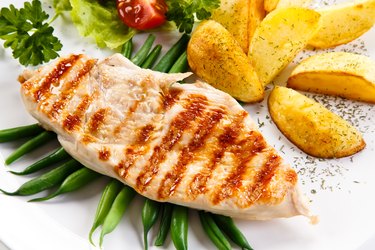
Boneless, skinless chicken is a versatile and healthy choice for lunch or dinner, as long as you're cooking your chicken without oil. If you opt for chicken breasts, a 4-ounce serving has just 160 calories and 2.5 grams of fat, but provides you with 27 grams of protein, according to the USDA.
Using butter or oil to cook your chicken negates the meat's naturally low calories and fat. You have a couple of options, though, for cooking up your main dish without the unwanted extras.
Video of the Day
Video of the Day
Read more: How to Bake a Plain Chicken Breast
Cooking Chicken Without Oil: Stovetop
Step 1: Add Water to Pan
Pan fry chicken breast with no oil by using water. Put about 1/4 inch of water in a Dutch oven or deep skillet. Set it on the burner and bring the water to a boil.
Step 2: Add the Chicken
Add two chicken breasts, or however many will fit without piling them on top of one another, to the boiling water. The water should not completely cover the chicken.
Step 3: Season Your Dish
Sprinkle the exposed chicken with the seasonings of your choice, such as salt and pepper, garlic powder, seasoned salt or cayenne pepper.
Step 4: Boil the Chicken
Turn the heat on the burner down slightly, but keep the water boiling. Keep an eye on the water. If it is close to all boiling away, add more, or your chicken will burn and stick to the bottom of the pan.
Step 5: Flip It Over
Watch the chicken. When the edges start to turn white but the top that you see is still pink in the middle, about four minutes, turn it over. Sprinkle more seasoning on this cooked side.
Step 6: Remove and Serve Hot
Cook for an additional three minutes or so, then make a small slit in the chicken and see if it is cooked through. All of the meat should be white. When it is done, remove it from the water with a fork and serve hot.
Check the internal temperature before consuming. According to the Academy of Nutrition and Dietetics, chicken should reach at least 165 degrees Fahrenheit before serving.
Bake Chicken in the Oven
Step 1: Heat the Oven
Heat your oven to 350 F.
Step 2: Pound the Chicken
Pound your chicken to a uniform thickness with the smooth side of the meat mallet. This will ensure that there are no uncooked spots in thicker areas when most of the chicken is done.
Step 3: Spray and Season
When cooking chicken with olive oil spray, coat a baking pan with nonstick cooking spray, then lay the chicken in one layer in the pan. Add seasonings for baked chicken.
Beware that some seasonings can increase the sodium content of your dish. The American Heart Association recommends a maximum intake of 2,300 milligrams of sodium per day, for healthy adults.
Step 4: Bake the Chicken
Cover the pan with aluminum foil to keep in moisture. Bake the chicken on the middle oven rack for 15 to 20 minutes. The total cooking time will depend on how many breasts are in the pan and how thick they are.
After 15 minutes, cut a slit in the thickest part of the thickest chicken breast. If it is still pinkish, continue baking, checking every couple of minutes, until it is white throughout. Serve warm.
Read more: General Nutrition Facts About Chicken
Beware of Other Sauces
If you've gone to the trouble of finding recipes for chicken breast without oil, don't ruin the healthful effect by covering it in a cream-, cheese- or oil-based sauce. If you prefer sauces to seasonings — or you like both at once — try topping it with salsa, a low-fat salad dressing or a low-calorie soup.
Things You'll Need
Dutch oven or deep skillet
Seasoning of choice
Fork
Flat-face meat mallet
Baking pan
Nonstick cooking spray
Aluminum foil
Warning
Wash your hands and your work surfaces thoroughly after they've been in contact with raw chicken.
Was this article helpful?
150 Characters Max
0/150
Thank you for sharing!
Thank you for your feedback!